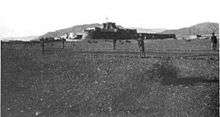Jamrud Fort


The Jamrud Fort is located besides Bab-e-Khyber at the entrance to the Khyber Pass in the Federally Administered Tribal Areas (FATA) of Pakistan.
History
In October 1836, Jamrud was conquered from the Khyberis by the Sikhs. Sardar Hari Singh Nalwa (1791-1837), the well-known Sikh general, proposed to build a big fort at Jamrud. The proposal was opposed; nevertheless the foundation of the fort that has survived was laid by General Hari Singh Nalwa on 6 Poh 1893 Sambat (18 December 1836) and the construction was completed in 54 days [1][2] "Jamrud...noted for its fort built with 10 feet (3 m) thick walls c.1836 by the Sikh Hari Singh Nalwa, one of Ranjit Singh's generals, was originally named Fatehgarh to commemorate the Sikh victory over the disunited tribes."[3]
Early in 1837, Maharaja Ranjit Singh's (1790-1839) grandson Prince Nau Nihal Singh was to be married. Hari Singh Nalwa sent his forces to Lahore for this historic celebration. At this time, Mr Fast, an Englishman, previously in the service of the British India Government, passed through Jamrud on his way to Kabul. En route he encountered Mohammad Akbar Khan, son of Dost Mohammad Khan. When Akbar Khan learnt that the fort at Jamrud was unprotected, he decided to attack. The battle between the Afghans and the Sikhs was fought on 30 April 1837. The loss suffered in this battle by the Sikhs was indeed heavy. Hari Singh Nalwa had sent out an appeal for help to the Maharaja to dispatch reinforcements from Lahore post haste, however his letter was not forwarded to the Maharaja by the Dogra chiefs. Reinforcements could not reach in time and Nalwa laid down his life in the battlefield.[4][5][6]
See also
| Wikimedia Commons has media related to Jamrud Fort. |
- List of UNESCO World Heritage Sites in Pakistan
- List of forts in Pakistan
- List of museums in Pakistan
References
- ↑ Jaffar, S.M. (1945). Peshawar: Past and Present. Peshawar: S. Muhammad Sadiq Khan. p. 120.
- ↑ Sandhu, Autar Singh (1935). General Hari Singh Nalwa. Lahore: Cunningham Historical Society. p. 74.
- ↑ Encyclopaedia Britannica (Micropedia). 6 (15th ed.). 1990. p. 492.
- ↑ Bakshi, S.R.; Pathak, Rashmi, eds. (2007). Punjab through the ages. Delhi: Sarup & Sons. pp. 194–5.
- ↑ Adamec, Ludwig W. (2011). Historical Dictionary of Afghanistan. Scarecrow Press. p. xxi. ISBN 0-8108-7957-3. Retrieved 2012-05-26.
1837: Lord Auckland appointed governor general. Akbar Khan, son of Dost Muhammad, defeats Sikhs at Jamrud...
- ↑ Jeffery J. Roberts, The Origins of Conflict in Afghanistan, p 4.
Coordinates: 34°00′12″N 71°22′43″E / 34.0034°N 71.3786°E